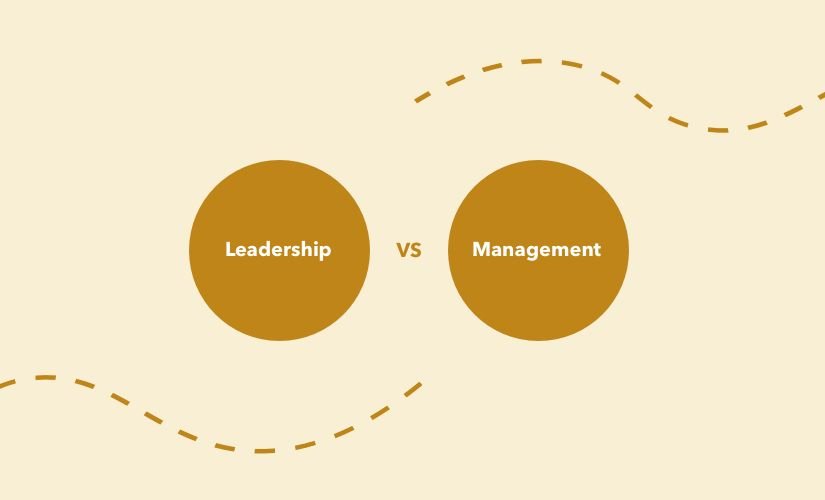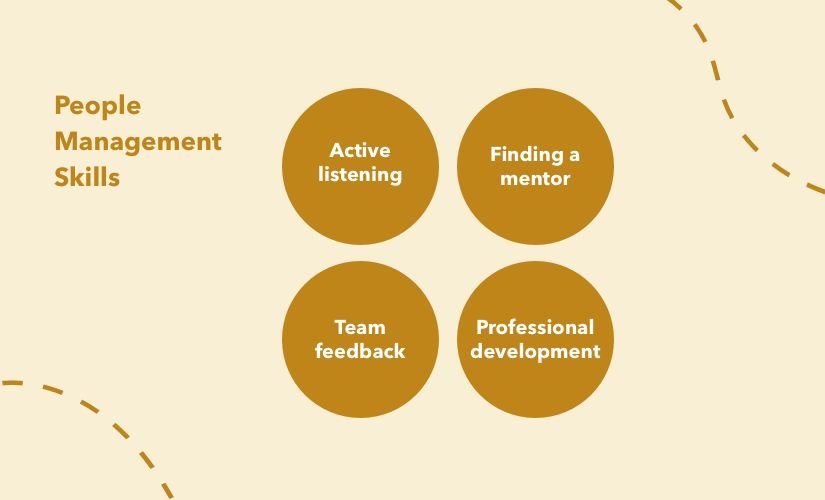
Article
5 min read
The Ultimate Guide to Managing People
Styrmir Masson
Feb 6, 2020
Chapters
The Ultimate Guide to Managing People
Dealing with people, with all of their perspectives, backgrounds and individual strengths, is arguably the most challenging aspect of management.
In this comprehensive guide to people management, we’ll look at:
- Definitions of the job
- Management styles
- Evolution of people management
- Handling conflict
- Delegation
- And more
What is people management?
Managers are often seen as organisers, leaders and delegators. They steer the ship of a company or department.
But that only paints part of the picture.
The discipline of people management is both broad and deep. And managing people brings its own unique complexities, as you deal with personalities, potential, career trajectories, team dynamics and more.
An effective manager of people needs to be adept at the following:
1. Conflict management
This means mediating conflict in a way that results in staff collaborating respectfully and effectively. A good people manager might be able to prevent incidences of conflict too, by fostering a kind, supportive and communicative workplace.
2. Company culture management
Company culture filters down from the top. So, a manager should have good rapport with their employees. These workers should feel happy, secure and fulfilled.
3. Project management
Ensuring the projects are finished on time and in a way that reflects the expertise and diligence of the company is a manager’s responsibility.
What do managers do?
Day-to-day life for managers varies according to industry. Some industries have near-instant customer turnaround (restaurants, for instance); while others nurture clients longer-term.
But regardless of whether KPIs are measured in assembly line productivity, sales goal completions or software updates developed, the principles for a good manager remain constant across all industries.
According to the Wall Street Journal, a manager establishes objectives, organises people, motivates and develops people.
On a macro level, a manager will:
- Interview and hire staff
- Manage long-term financial and expansion goals for a company
- Liaise between their team and upper management
On a more day-to-day level, this means:
- Ownership of operations and regular duties
- Delegating tasks
- Evaluating work undertaken
Management style varies, naturally, but an effective way to get the most out of staff is to encourage their ambitions and nurture their interests.
How has managing people changed in recent years?
Management and business styles are constantly evolving. In recent years, focus has shifted towards responsibility and a sense of purpose beyond balance sheets.
For instance, in recent years AIA Group in China is no longer just an insurance firm – it’s also a wellness company. Netflix expanded from becoming a streaming provider to an Oscar-winning content creator. Phillips, most dramatically, has done away with most of its lighting business and is now moving towards healthcare technology.
Employees too, want a sense of purpose and meaning in their work. Recent employee surveys (like Mercer’s Global Talent Trends survey) have found that staff are thrice as likely to work for a company with a strong sense of purpose. Other priorities that have risen in recent years include wellness, flexibility and work/life balance.
Feeling encouraged and having a voice have also risen in employees’ priorities. A report from Salesforce found that employees who believe their voice is heard are almost five times more likely to feel empowered to perform to the best of their abilities.
Consequently, while managers of the past (even a few years ago) might be expected to maintain a distance and focus on results; today’s effective people managers are concerned about their teams’ motivations, training and fulfilment.
Different management styles
Every manager has their own style. The key is to combine your own strengths with those of other styles. Here are some different approaches you might take. Remember to combine elements of some, not to embrace any one of them 100%.
1. Authoritative
As you might imagine, this is not a democratic leader – rather, one who is clearly in charge. Some workers enjoy having these kinds of managers. A strong, authoritative boss would have vision and directness. Many find this type of decisiveness and efficiency inspiring.
However, this style might also alienate staff if it’s left unchecked, especially in today’s more democratic workplace climates. Even if your style is authoritative, it’s important to remember when to listen to staff and give them some control, especially if they’re experts in their field.
Well-known examples of authoritative bosses would be Jeff Bezos or Mark Zuckerberg.
2. Pace-setting
Famously, Bill Gates is said to work at a pace that can be hard to keep up with.
There’s a good chance you’ve worked for a pace-setting boss. These bosses work quickly and to high standards, without showing strong interest in collaboration or others’ way of doing things.
Naturally, this can be a difficult environment for some. And it can lead to high staff turnover. But it’s also appropriate and helpful in certain contexts and environments, like a high-pressure crunch time or if a company is raising pace unexpectedly.
3. Coaching
Increasingly, employers and managers are hiring with potential in mind. In other words, they take on an employee with the hope and expectation that they’ll upskill and improve throughout their career.
It’s a management style that demands a lot: managers need to build trust and invest time in coaching; while staff also must be motivated and on board with this style. Long-term though, it can pay rich dividends, with loyal staff, up-to-date skills in the company and a satisfied, productive workforce.
There’s also a risk of training up staff only for them to leave. But as Henry Ford once said: “The only thing worse than training your employees and having them leave is not training them and having them stay.”
4. Democratic
A manager with a democratic style believes in sourcing the opinions of staff when it comes to major decisions. This works tremendously well if the company is pivoting and the manager wants buy-in from staff. It’s also a good way to gain perspective and insights from a company’s collective experience and knowledge.
It can be slower than other methods, though, as consensus is sought, and decisive actions are not implemented promptly.
Howard Shultz, CEO of Starbucks is well known for his democratic style. In fact, he says that he encourages executives to push back if they have doubts or disagreements.
5. Coercive
This style is blunt and direct. It’s a style that suits emergencies (indeed, emergency service jobs) and hard deadlines. But it’s not advisable long-term, as it’s unsustainable, leading to resentment and maybe burnout.
6. Affiliative
A friendly boss who fosters a kind, familial workplace, the classic affiliative manager is the kind satirised in The Office (especially Michael Scott in the US version).
This style – when done the right way – has a myriad of benefits. It can lead to happy, loyal and dedicated employees. And it can lead to your company having a good reputation to both work for and deal with.
Handled the wrong way, of course, and discipline and productivity can suffer. Communication too can suffer with the familial style, as feedback can become more fraught.
The difference between leadership and management
While it’s important to be an effective manager, the real ambition is to become a great leader. But what’s the difference?
The key difference is that a leader thinks for themselves and looks at the long-term. A manager has goals, while a leader has vision; people work for a manager and look up to a leader; managers have employees, a leader has a team.
There is no easy way to accomplish these kinds of working relationships, but you can work towards it by valuing your team, being honest and becoming an exceptional manager. On that note…
What makes a good manager?
A good manager is a combination of qualification, experience and the right personal traits.
If you don’t think you naturally have these skills, they can be worked on, either with a course, or by researching and practicing.
A good manager is:
- Effective at conflict resolution. Can you resolve a dispute amicably and successfully for both parties?
- Respectful. Does your team get the professional treatment they deserve?
- Critical thinker. How good are you at analysing business situations, the market, trends and people?
- Empathetic and emotionally intelligent. Can you put yourself in others’ shoes and are you willing to invest in truly listening to people?
- Communicative. Are you clear and candid with your intentions for the task and for the company in general? Does your team know where they stand?
- Trustworthy. Are you true to your word? Do clients and staff trust you?
It’s hard to overestimate the potential fallout of a bad manager. Staff turnover is, of course, costly. There’s a real, financial cost in losing an employee, linked to the time it takes to find a replacement and the time it takes for the replacement to be trained up.
And even before leaving, an employee who’s not managed the right way can be unmotivated and despondent. Productivity can suffer, resulting projects or products might suffer reduced quality.
Loss of trust is a common reason for staff unhappiness. Just like outside the workplace, lost trust is hard to rebuild. This loss can happen if a manager is inconsistent or breaks a promise; if they take credit for an employee’s work or if they’re not transparent and honest about the direction of the team or company.
How to level up your people management skills
As you probably know, there are training courses available specifically for management, but there are also skills to work on in a less formal manner. These include:
- Active listening. Are you looking people in the eye, ignoring distractions (like your phone and monitor) and taking on board what someone is saying when they talk to you? These are hallmarks of a good listener, and skills to work on.
- Finding a mentor. Whether it’s a former or present manager, or someone you look up to professionally, people are often happy to share their wisdom and experience with someone eager to learn.
- Encouraging feedback from your team or other managers. This can be in the form of a questionnaire, or a less formal meeting to evaluate how you’re doing.
- Professional development: unfortunately, much of what you learn in college will be obsolete shortly after graduation. This is why it’s important to regularly upskill, with external training, keeping up on industry trends, online courses, or all of the above.
Tips for becoming a better manager
As well as training and mentoring, you can put into practice the following actions that will serve to reassure your team and hone your team-management effectiveness.
Here are some practical steps that will help maintain productivity and a feeling of security in your team:
- Schedule 1/1 sessions with team members. A regular check-in will help remind team members that they’re noticed and will help nip any problems in the bud.
- Check-in even when things seem to be going well. An employee might be productive, but struggling, and afraid to talk to you about it.
- Keep your own emotions in check. Try to maintain an even keel, even if you’re feeling anxious, angry or nervous. Your team looks to you for support.
- Always give negative feedback in private: minimise tension and maintain dignity by keeping some conversations private.
- Set objectives and SMART goals: a clear list of goals that are Specific, Measurable, Achievable, Realistic and Timely.
- Be transparent about business goals and changes.
Building trust in the workplace
Just like in everyday life, trust takes time to build up and has to be nurtured and maintained in the workplace. Here’s how you can foster a trusting environment…
Be consistent
Your team should feel secure and confident in your jobs. This means that you are not unpredictable, you’re even-tempered and that you won’t spring surprises on them. Sometimes emergencies or big workloads can come out of nowhere: if that happens, give as much notice as possible, be direct and honest, and help in any way you can to minimise disruption.
Invest in your staff’s development
Employees should know that they’re being invested in long-term, that you have confidence and high hopes in them. This could translate to facilitating their learning (with flexible hours and maybe even a financial commitment) or mapping out a clear career path for them, showing how they can earn promotions and the steps they need to take to make that happen.
Give praise and credit
Yes, a salary is one way to show appreciation, but it costs nothing to acknowledge good work, strong ideas or a pleasant attitude. Praise and appreciation are always welcome. And it helps remind staff that they’re not anonymous or invisible.
Handling conflict as a manager
Conflict is an unpleasant but often inevitable part of business, especially as your team grows. Here’s how to approach a fraught situation:
1. Use neutral language.
Separate the people and personalities from events in your language. So, instead of “when did you do this” say things like “when this happens”. This is about analysing and finding a solution, not apportioning blame.
2. Talk to each party separately.
Take the time to have individual conversations, so you can hear each side in a welcoming, calm environment.
3. Actively listen.
Listen to each side, take notes, allocate the same volume of time to each party. And, most importantly, actively listen. This means you don’t prepare a reply until you’ve heard their side. You look them in the eye. And you do your best to put yourself in their shoes, even if you disagree.
4. Collaborate with each party on establishing what the situation is.
Summarise the findings of the initial conversations with the conflicting employees and establish that this is the area of disagreement. Often, the situation can be resolved at this stage, as it might be a communications issue. Other times, a solution might emerge that pleases both sides.
5. Work on a solution together.
Ask each party individually what their ideal outcome would be, and then try to craft a solution that works for all.
6. Know when to involve HR
If a solution is not emerging, this might be the time to bring in the expertise of a HR executive.
We’ve covered this subject in more detail here: How to Solve the 4 Most Common Team Conflicts and here: How to fire someone: A six-step action plan.
Managing difficult people
Some staff who seem to be the ideal candidate don’t always work out that way when they start the job. And, as dissatisfaction grows, an employee might become difficult or obstinate.
For problem employees, you need to figure out who’s an asset or a liability on your team. Then, take the following steps:
Acknowledge the problem.
Nobody likes confrontation, but with any problem, ignoring it might make the issue worse. Staff morale will suffer, productivity might continue to be an issue, and clients might notice problem employees. Longer-term, it might affect your revenue and staff turnover.
Start with a meeting.
Instead of ignoring it, talk to the employee. Hold a meeting – ideally in a neutral meeting room – and let them speak their mind before making any accusations. There might be issues with their personal life, feeling burned out or overwhelmed or with other employees.
Try to repair the issue amicably. You can even do this if you need to make a warning.
If they’re feeling stranded or lost, help them work through it with whatever resources you have. If it’s a personality clash, you can work through that too – possibly chatting to other colleagues. If it’s a disciplinary issue, you can outline what needs to be changed. There’s no single solution to these issues, so listening and working with the person is the only way to find the right result.
Follow through.
Having outlined and established what needs to change, set a deadline for these improvements and have a follow-on meeting. If things have not improved, the next steps might be disciplinary. This might take the shape of closer monitoring, another warning or a change of their duties (if they have shown a breach of trust). If problems persist, that’s when HR should be consulted.
Delegating as a manager
The main point of being a manager, of course, is not having to do everything yourself. But delegation can bring its own challenges. Here’s how you can distribute the work throughout your team, fairly and efficiently.
Start small
When a new hire is beginning, or the company’s workload is expanding or pivoting, it’s tempting to draft in all hands at short notice. However, it’s less stressful for all involved if you start the delegation incrementally.
Begin with tasks that you’re fully confident the employee can do. Provide training if necessary. And try to avoid tight deadlines the first time they’re trying something new. Soon enough, you’ll learn their strengths, limitations and how long it takes for them to do each task.
Practice what you preach
In other words, don’t delegate something you would not do yourself – or that you have never done. Try to be reasonable in what you ask and don’t make a habit of offloading boring or awkward tasks to your team.
Choose the right people
This applies not just to the role you’re hiring, but for the tasks you’re assigning. Can they carry it out autonomously? Does it play to their strengths?
One employee might have a keen editorial eye, another might be a master at assembling attractive PowerPoint presentations, while another excels at public speaking.
Outline the tasks clearly
Make sure that staff have a clear outline of what they need to do, as well as a clear deadline. Some companies work by calendar weeks or months for clarity (though not every task will be as clear cut). A template or guidelines for the task is helpful too, if possible.
Trust them
Yes, check in. And remind them that they can come to you if they’re struggling or falling behind, or if they just need some guidance. But ultimately, people respond well to being trusted and left to work on their own. In other words, keep in touch, but try not to be overbearing.
Motivating employees as a manager
Even in the happiest workplace, fatigue can set in. So how can a manager maintain productivity and happiness in their team? Like many managerial skills, communication is key.
1. Acknowledge good work
This one is simple in theory, but easy to forget. Some managers believe that salary is acknowledgement enough. However, it takes mere moments to send a brief email or message saying: “good job”. For bigger achievements, public acknowledgements are often a good idea – a news blast to the rest of the team about a job well done.
2. Keep them informed
Staff don’t like to be in the dark or speculating about how or the company is doing. So, keep an open door and let them know bigger picture news, how their work is helping the company, and what the team and company’s long and medium-term plans are.
3. Be reasonable with deadlines
One way to alienate staff is to ask too much of them. Instead, communicate clear, attainable deadlines. Their workload should be doable within a full working week. If not, look to hire additional staff or freelancers; or even turn work down. Sooner or later, an overworked employee will hand in their notice.
4. Reward your team
This is especially important after difficult times – after a crunch time for a major project, or after a major win. The reward might be as simple as going home early, a bottle of wine or a small voucher. Acknowledgement is as important as the material value of the reward.
5. Communicate with them
The appropriate level of communication you have with your team will depend on their own preferences and working style. Maintain open communication, make it clear what the expectations and especially KPIs (key performance indicators) are. And, even if you’re off site, be available to answer questions. You’ll find out more in our guide to giving employees feedback.
6. Have a career path
Fulfilment is a regular fixture in employee surveys, as more and more workers want to have an overall goal, a sense of purpose and a career path. Work with your employee (and ideally HR) to map out what a career path would look like in the medium or long term. This would include specific promotion opportunities and skills required to reach those milestones.
How to measure your own performance as a manager
Quantifying can be tricky in a work environment, but thankfully there’s precedent for just about everything. That includes the effectiveness of managers and team leaders.
Here are some ways you might measure your own performance as a manager:
- Staff churn. Is staff turnover frequent, or are employees happy to stay? Staff turnover (i.e., percentage of staff who left their job for any reason) tends to hover around 15-20% per year, but varies hugely from industry to industry. Civil service jobs have unusually low turnover, for instance; while service industries’ turnover is especially high.
- Productivity. A happy, well-run team is a productive one, so you can measure the team’s success by how KPIs like revenue, percentage of targets reached, or number or projects completed on time (to use just three examples). Again, this varies across industries.
- Employee surveys. Every workplace should survey their staff at least once or twice a year. They should paint a clear picture of workplace satisfaction.
- Career trajectories. Your team should be evolving and improving for as long as they’re working for you. If they remain stagnant after two years, having acquired no skill or advancement, that needs to be addressed.
For more on this subject, check out our post on productivity hacks for managers.
People management books every first-time manager should read
There is no shortage of knowledge on management – and indeed, an abundance of managers who are happy to share their opinions! With management styles changing frequently, it’s important to stay up to date on collective knowledge and trends. Here are some of the most acclaimed management books of recent years:
- Back to Human: How Great Leaders Create Connection in the Age of Isolation by Dan Schawbel – a book about the increasing importance of workers feeling empowered, connected and engaged with their work.
- The Making of a Manager: What to Do When Everyone Looks to You by Julie Zhuo – based on personal experience, Zhuo’s book is a how-to guide, covering everything from building trust to leading with confidence.
- The Sensational Leader: A Story of Growth: Providing a Simple Path to Becoming a Leader Worth Following by Duane Cummings – author Duane Cummings draws on lessons learned from mentors as well as his own experience, creating a practical, helpful and engaging guide to modern management.
Choosing the right tools to help you manage better
Today’s managers have plenty of help in the form of apps, programmes and AI. It makes sense to outsource some of the management admin to automation. Here are some very handy tools to help make your management life that bit easier:
- Timeclock. A handy tool, courtesy of Planday, that takes the pain out of payroll and time-tracking.
- Asana. Centralises all ongoing projects with interactive, elegant to-do list software.
- Trello. Essentially, this is a virtual, collaborative online whiteboard.
There are also several online management courses (including a range on Linkedin, among others) to help you hone your skills.
Planday: Making management easier
See for yourself what Planday can do to help your organization with our employee management software.

Why Giving Your Team Feedback is so Important
With some advance preparation and training, you can create a dynamic team that successfully gives and receives feedback

Solving your workforce management challenges
We reveal the most common workforce management challenges facing SMBs and share with you some best practice tips to resolve them







